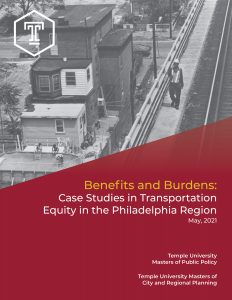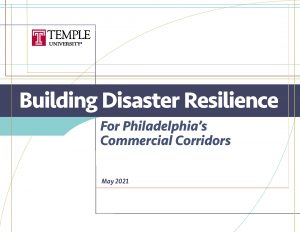2020 brought both a once-in-a-lifetime pandemic and a long-overdue reckoning with systemic racism to the City of Philadelphia. Both studio projects this year address these critical planning issues head on. One team of eight students, working alongside students in Temple’s Master of Public Policy program, investigated the impacts of transportation projects funded by DVRPC (our region’s MPO) and developed a new framework for evaluating equity. Our other team worked with Philadelphia’s Commerce Department to document how the city’s commercial corridors managed through the dual challenges of the COVID-19 pandemic, and this year’s civil unrest. Their City-Wide Resiliency Plan sets an agenda for Philadelphia’s planning efforts for years to come.
 Benefits and Burdens: Case Studies in Transportation Equity in the Philadelphia Region
Benefits and Burdens: Case Studies in Transportation Equity in the Philadelphia Region
The murder of George Floyd in May 2020 sparked a racial reckoning in America. Demonstrators marched for months demanding justice, and those calls have grown beyond police reform. Public and private agencies around the country are reckoning with their own history and culpability in systemic racism and inequity.
In June 2020, The Delaware Valley Regional Planning Commission (DVRPC) held a series of internal meetings aimed at redirecting the agency’s work program to begin the process of redressing historical inequities. As part of that initiative, DVRPC asked Temple University’s Public Policy (MPP) and City and Regional Planning (MCRP) graduate students to examine a breadth of projects that the agency has funded or planned with an equity lens. The Policy Team researched three projects that appear in Volume II of this report and the Planning Team researched five projects that appear in Volume III of this report.
Volume I provides background, context, and research on best practices on doing a transportation equity analysis. Volume II examines the Blue Route (I-476), the Market-Frankford Line reconstruction, and the Vine Street Expressway (I-676). Volume III examines NJ-29, PATCO, Direct Connection, US 422, and the Schuylkill River Trail.
Both Volumes II and III examine these transportation projects, or case studies, from an interdisciplinary lens, with the Policy Team’s Volume II focusing on a political and public policy perspective, and the Planning Team relying primarily on a regional planning angle. Taken together, the case studies across these two volumes present a comprehensive view of how to best analyze equity in transportation planning as both perspectives are crucial to properly addressing the complexities of performing equity analyses.
Overall, the results of the analysis showed that equity has improved in transportation projects over time regionally, with major regulations such as the Title VI, the EJ Executive Order, and the National Environmental Policy Act (NEPA) playing crucial roles in this improvement. In addition, DVRPC has been a relative leader among MPOs in incorporating equity into their transportation analysis. However, improvement does not equal success, and the Philadelphia area is still not close to reaching true equity in transportation, and therefore must make major changes in both its policies and planning practices to finally reach this goal. Further complicating the challenge is that the longevity of transportation projects often ensures that inequitable decisions made decades ago still affect people today.
Files:
- Full Report, including all appendices [PDF]
- Sections:
- Presentation to DVRPC Board, May 27, 2021 [Slides: PPT] [Recording: MP4]
 Building Disaster Resilience for Philadelphia’s Commercial Corridors
Building Disaster Resilience for Philadelphia’s Commercial Corridors
Commercial corridors are the center of Philadelphia’s communities. They bring essential goods and services to neighborhoods, including barbery, groceries, hardware, and professional services. Having an array of services in the neighborhood is especially important for the 30% of Philadelphia households who do not own a car. Further, they act as social destinations where community members meet at coffee shops, nail salons, restaurants, and even on the sidewalk. When the pandemic and civil unrest of 2020 rattled our lives, our commercial corridors were not immune. While the dust began to settle by the spring of 2021 and the city was able to adapt their response, 2020’s many lessons in disaster response must be synthesized.
Working with the Philadelphia Department of Commerce, and partners at PACDC and LISC, one Graduate Planning Studio team investigated and reported on the Department’s emergency response, and created recommendations for responses to further disasters. Woven throughout our findings is the concept that the privileges of wealth, race and ethnicity, language, and education were the biggest predictors of resilience to these disasters.
While wealthy and educated corridors and merchants were able to ride out two once-in-a-generation disasters with relative ease, those who have always been underserved in the United States suffered disproportionately and needlessly, as their personal and organizational resources were inadequate to weather the storm and stakeholders inadequately reached these communities.
The After Action Report summarizes the experiences of commercial corridor stakeholders during the 2020 disasters, and the City-Wide Resiliency Plan lays the groundwork for greater commercial corridor resilience in anticipation of whatever disasters lay ahead. To better serve corridor managers, a Corridor Manager Toolkit, including a Merchant Checklist, were also developed by the team.
Files: